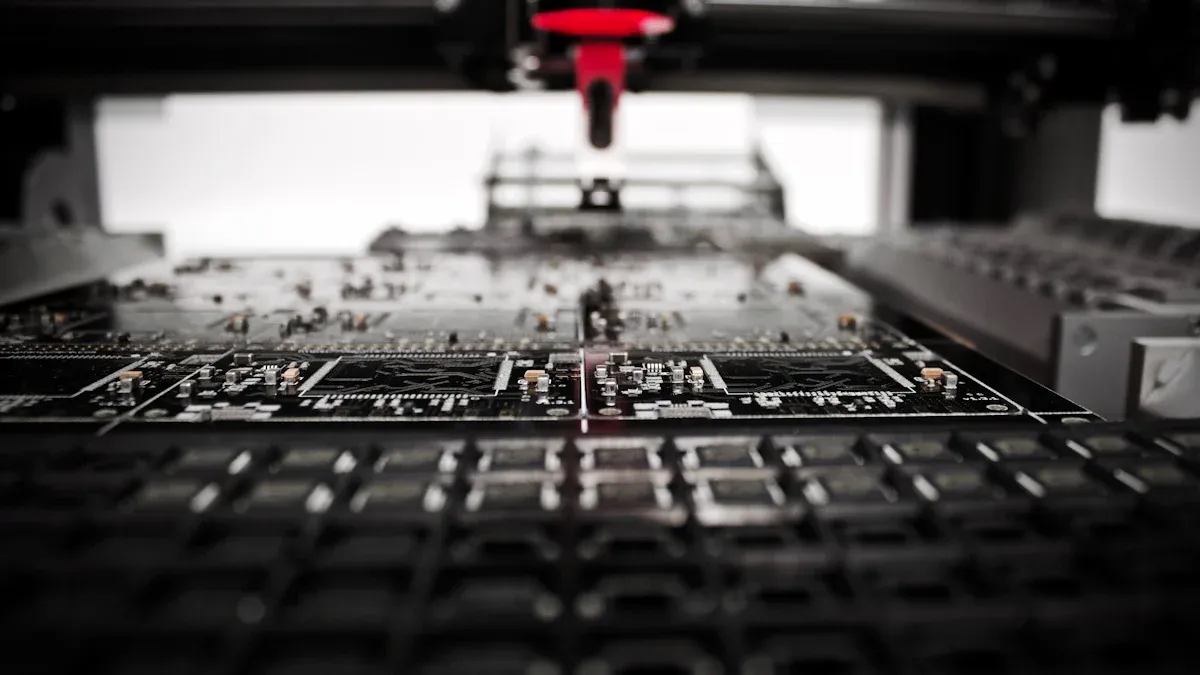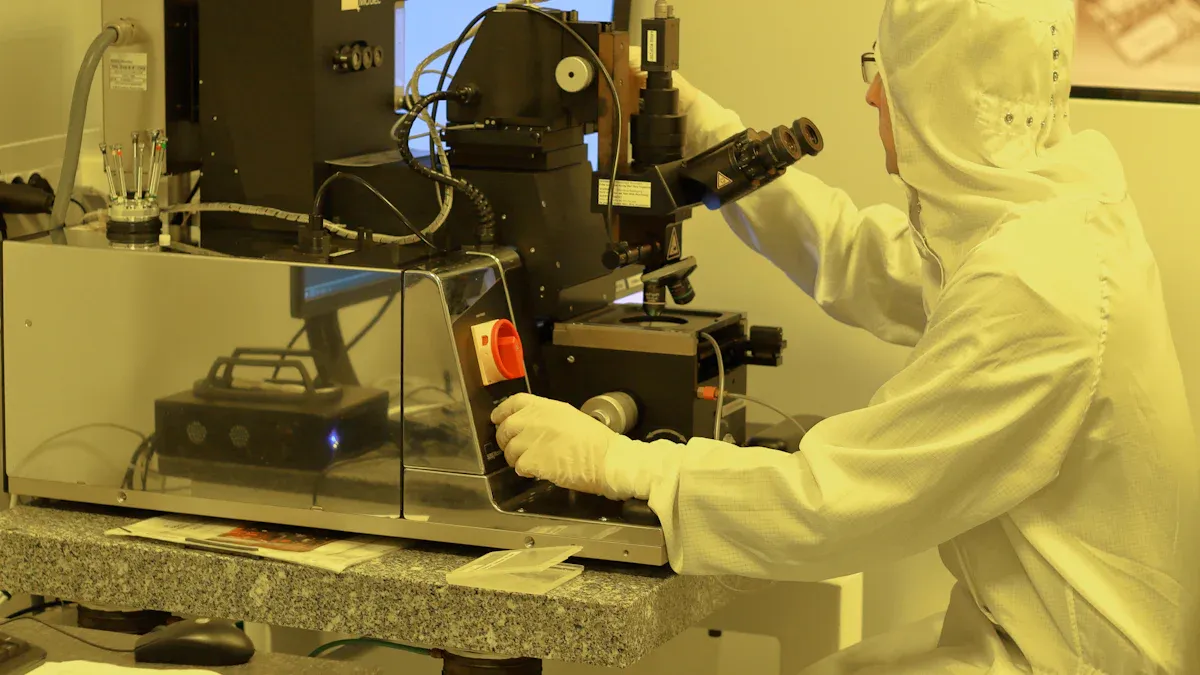
An MOCVD epitaxial wafer susceptor plays a pivotal role in the Metal-Organic Chemical Vapor Deposition (MOCVD) process. It supports the substrate and ensures precise heating during thin film deposition. This component is essential for achieving uniformity and quality in semiconductor devices, making it indispensable in advanced electronics manufacturing.
Key Takeaways
- An MOCVD wafer susceptor holds wafers steady during deposition. It keeps them stable and aligned to make good semiconductor devices.
- Even heat is very important in the MOCVD process. The susceptor spreads heat evenly to reduce thin film defects.
- Strong materials like graphite and silicon carbide make susceptors last longer. This improves how they work and lowers repair costs.
The Role of an MOCVD Epitaxial Wafer Susceptor

Supporting wafers during epitaxial growth
An MOCVD epitaxial wafer susceptor provides a stable platform for wafers during the epitaxial growth process. It holds the substrate securely in place, ensuring precise alignment throughout the deposition. This stability is critical for maintaining the integrity of the thin film layers. Without a reliable susceptor, the substrate could shift or vibrate, leading to defects in the final semiconductor device. Manufacturers design these components to accommodate various wafer sizes, enhancing their versatility in different applications.
Ensuring uniform heat distribution and temperature control
Temperature uniformity is essential in the MOCVD process. The susceptor plays a key role in distributing heat evenly across the wafer surface. Its material composition and design allow it to absorb and transfer heat efficiently, minimizing temperature gradients. This uniformity ensures consistent chemical reactions during deposition, which directly impacts the quality of the thin film. Advanced susceptors often incorporate features that enhance thermal conductivity, further improving temperature control.
Facilitating consistent thin film deposition
The MOCVD epitaxial wafer susceptor contributes to the precision of thin film deposition. By maintaining a stable temperature and supporting the wafer, it creates an ideal environment for the chemical vapor deposition process. This consistency reduces the likelihood of defects such as uneven thickness or impurities. As a result, the susceptor plays a vital role in achieving high-performance semiconductor devices.
Materials Used in MOCVD Epitaxial Wafer Susceptors
Graphite: thermal conductivity and machinability
Graphite serves as a foundational material in the construction of an MOCVD epitaxial wafer susceptor. Its exceptional thermal conductivity ensures efficient heat transfer, which is critical for maintaining uniform temperatures during the deposition process. Additionally, graphite’s machinability allows manufacturers to shape it into complex designs that meet specific process requirements. This adaptability makes it a preferred choice for creating susceptors that accommodate various wafer sizes and configurations. Despite its advantages, graphite requires protective coatings to enhance its durability and chemical resistance.
Silicon carbide coatings: durability and chemical resistance
Silicon carbide (SiC) coatings are applied to graphite susceptors to improve their performance and longevity. These coatings provide a robust barrier against chemical reactions that occur during the MOCVD process. SiC’s high hardness and thermal stability protect the underlying graphite from wear and degradation. Furthermore, its chemical resistance prevents contamination of the thin films being deposited. This combination of properties ensures that the susceptor remains reliable even under harsh operating conditions, contributing to consistent thin film quality.
Importance of material selection for performance and longevity
The choice of materials directly impacts the performance and lifespan of an MOCVD epitaxial wafer susceptor. High-quality materials like graphite and silicon carbide enable the susceptor to withstand extreme temperatures and corrosive environments. Proper material selection minimizes maintenance and replacement costs, enhancing overall process efficiency. By prioritizing durability and thermal performance, manufacturers can achieve superior results in semiconductor production.
Benefits of High-Quality MOCVD Epitaxial Wafer Susceptors
Enhanced film quality and uniformity
A high-quality MOCVD epitaxial wafer susceptor ensures superior film quality by maintaining precise temperature control and stability. This precision minimizes defects such as uneven thickness or impurities in the deposited thin films. Uniform heat distribution across the wafer surface promotes consistent chemical reactions, resulting in films with exceptional uniformity. These characteristics are essential for producing advanced semiconductor devices that meet stringent performance standards. Manufacturers rely on these susceptors to achieve the high-quality films required for cutting-edge applications.
Improved process efficiency and yield
The use of a reliable MOCVD epitaxial wafer susceptor significantly enhances process efficiency. Its ability to maintain stable operating conditions reduces the likelihood of errors during deposition. This stability leads to fewer defective wafers, improving overall yield. Additionally, the optimized thermal performance of the susceptor shortens processing times, enabling manufacturers to produce more devices in less time. These improvements contribute to a more efficient and cost-effective production process, benefiting both manufacturers and end-users.
Increased durability and cost-effectiveness
Durable materials like graphite and silicon carbide coatings extend the lifespan of MOCVD epitaxial wafer susceptors. Their resistance to wear and chemical degradation ensures consistent performance over multiple production cycles. This durability reduces the frequency of replacements, lowering maintenance costs. Furthermore, the long-term reliability of these susceptors minimizes downtime, maximizing operational efficiency. By investing in high-quality susceptors, manufacturers achieve a balance between performance and cost-effectiveness, ensuring sustainable production practices.
The MOCVD epitaxial wafer susceptor remains a cornerstone of the MOCVD process. Its ability to support wafers, distribute heat uniformly, and ensure consistent thin film deposition directly impacts the quality of semiconductor devices. By utilizing durable materials like graphite and silicon carbide, manufacturers achieve enhanced performance and longevity. This critical component drives innovation in semiconductor manufacturing, enabling the production of advanced electronic devices.
FAQ
What is the primary purpose of an MOCVD epitaxial wafer susceptor?
The susceptor supports wafers during deposition and ensures uniform heat distribution. This stability enables consistent thin film growth for high-quality semiconductor devices.
Why is silicon carbide coating used on susceptors?
Silicon carbide enhances durability and chemical resistance. It protects the susceptor from wear and contamination, ensuring reliable performance in harsh MOCVD environments.
How does material selection impact susceptor performance?
Material choice affects thermal conductivity, durability, and chemical resistance. High-quality materials improve efficiency, extend lifespan, and reduce maintenance costs in semiconductor manufacturing.


